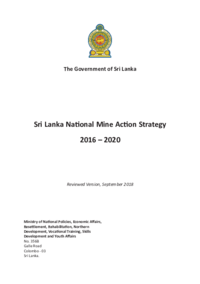As mandated by Sri Lanka’s National Mine Acti on Strategy 2016-2020, this reviewed version is the result of the mid-term strategy review, organised and facilitated with the support of the Geneva
International Centre for Humanitarian Demining (GICHD) in April 2018. A core principle underpinning the development of the strategy and the mid-term review was that these processes should be inclusive and participatory, based on lessons learnt and good practices drawn from the global mine action sector. The mid-term review revealed major achievements in Sri Lanka’s mine acti on programme since 2016, including:
• The completion of resurvey activities in early 2017, resulting in the release of large areas of safe land and clarity on the remaining mine/explosive remnants of war (ERW) contamination (first outcome, strategic objective 1).
• Sri Lanka’s accessions to the Anti-Personnel Mine Ban Conventi on (APMBC) in December 2017 (first outcome strategic objective 3) and to the Convention on Cluster Munitions (CCM) in March 2018 are important accomplishments in the Advocacy sector and signalled a clear commitment to the international disarmament agenda.
• Considerable progress has also been made in the Mine Risk Education (MRE) sector, in particular related to the development of sustainable MRE structures.
The Government of Sri Lanka (GoSL) remains committed to mine action, evident in its increased budgetary support to the mine action programme over the last few years. It will continue working in close collaboration with its national and international stakeholders to ‘getting the job done’ and to rid Sri Lanka of its landmines. This will result in the release of previously contaminated land, thereby enabling cultivation and other livelihood activities, safe access to public services (including schools and health facilities), the rehabilitation of infrastructure, the preservation of wildlife and the development of tourism.
The possibility of declaring completion of Sri Lanka’s clearance obligations under the APMBC in the near future provides the GoSL and the international community with an opportunity to be part of a
truly inspiring success story. The Government is confident that Sri Lanka’s reviewed strategy provides a clear strategic orientation for achieving this goal. It is evident however that completion of clearance by the end of 2020 will only be possible if considerably more funding is made available, allowing all operators to expand to their optimal capacity. It is clear that the programme needs to attract more international donors to support completion and that the current reliance on a limited number of international donors makes the programme more financially vulnerable.
As completion approaches, the Government will, in line with commitments presented in this strategy, ensure that relevant plans are in place to ensure a smooth demobilisation of deminers and effective management of residual contamination.
Category: National Strategies

